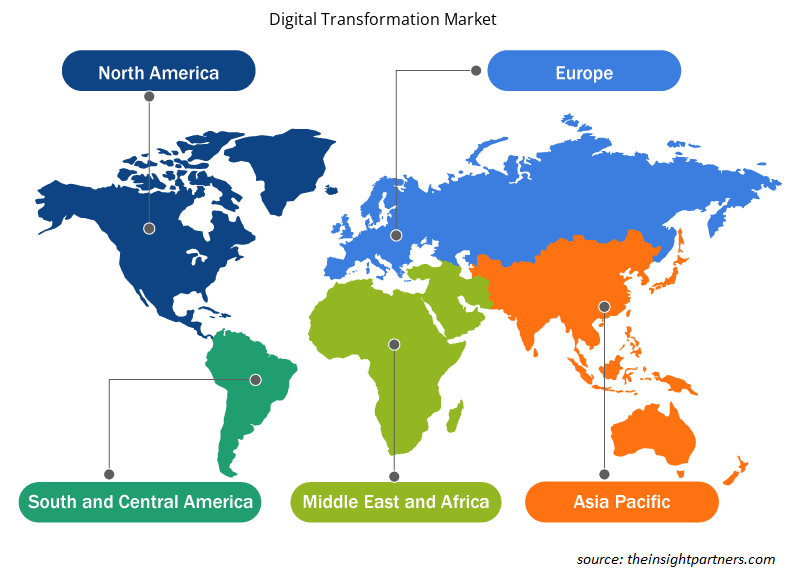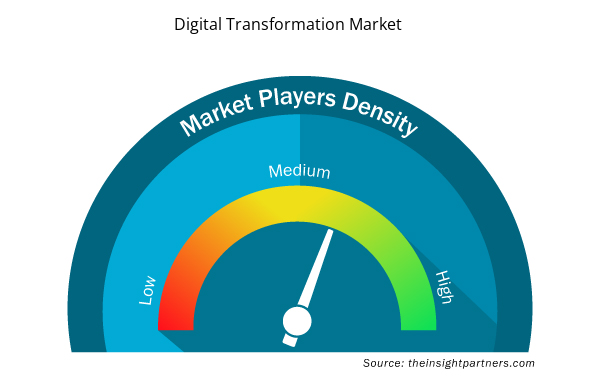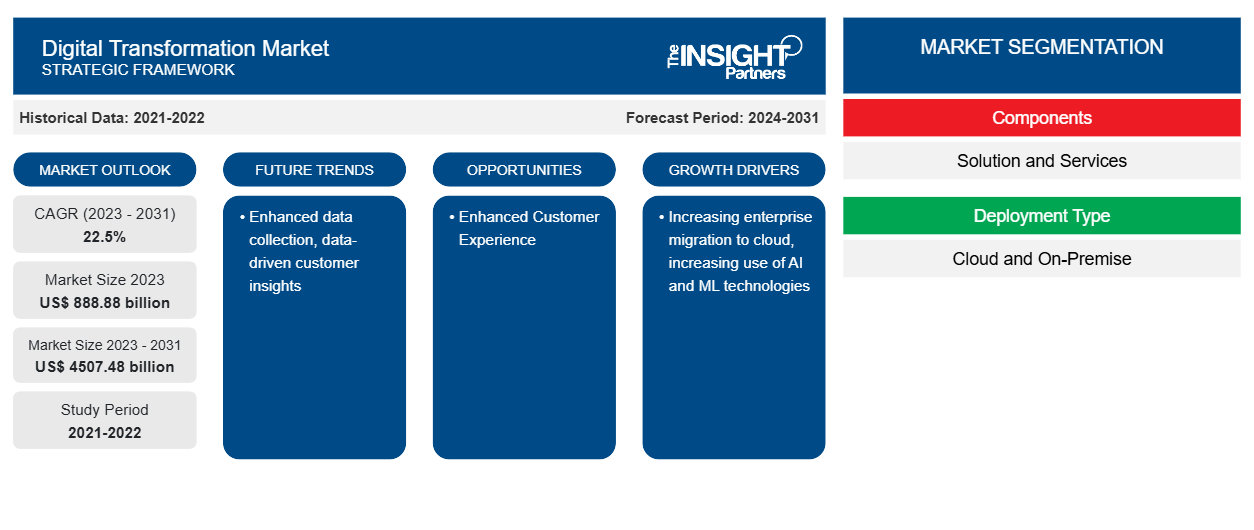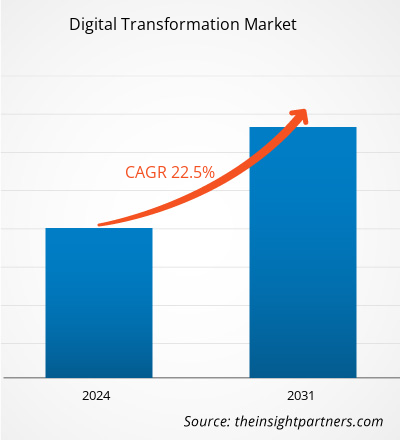Das Marktvolumen für die digitale Transformation soll von 888,88 Milliarden US-Dollar im Jahr 2023 auf 4507,48 Milliarden US-Dollar im Jahr 2031 anwachsen. Der Markt wird voraussichtlich zwischen 2023 und 2031 eine durchschnittliche jährliche Wachstumsrate (CAGR) von 22,5 % verzeichnen. Verbesserte Datenerfassung und datengesteuerte Kundeneinblicke werden voraussichtlich weiterhin wichtige Markttrends für die digitale Transformation bleiben.
Marktanalyse zur digitalen Transformation
In den sich ständig weiterentwickelnden globalen Unternehmensabläufen ist die digitale Transformation für Unternehmen unabdingbar geworden, um auf dem Markt relevant und effizient zu bleiben. Alle Organisationen, ob klein oder groß, gehen zunehmend dazu über, ihre Abläufe durch die Migration in die Cloud zu rationalisieren. Um Kundennutzen zu schaffen, müssen digitale Technologien in jeden Geschäftsbereich integriert werden. Dies treibt das Marktwachstum voran.
Marktübersicht zur digitalen Transformation
Laut den vom Weltwirtschaftsforum veröffentlichten Prognosen werden der Weltwirtschaft bis 2025 durch die digitale Transformation 100 Billionen US-Dollar zufließen. Organisationen auf der ganzen Welt haben digitale Strategien eingeführt, um ihre Erfolgsquoten zu erhöhen.
Passen Sie diesen Bericht Ihren Anforderungen an
Sie erhalten kostenlose Anpassungen an jedem Bericht, einschließlich Teilen dieses Berichts oder einer Analyse auf Länderebene, eines Excel-Datenpakets sowie tolle Angebote und Rabatte für Start-ups und Universitäten.
- Holen Sie sich die wichtigsten Markttrends aus diesem Bericht.Dieses KOSTENLOSE Beispiel umfasst eine Datenanalyse von Markttrends bis hin zu Schätzungen und Prognosen.
Markttreiber und Chancen für die digitale Transformation
Zunehmende Migration von Unternehmen in die Cloud begünstigt den Markt
Die Cloud-Migrationsstrategie von Unternehmen kann als die Umstellung von einer Infrastruktur vor Ort auf einen virtuellen Dienst verstanden werden, der unter anderem Skalierbarkeit, Rechenleistung , Speicher und Netzwerkdienste auf Abruf bietet. In dieser digitalisierten Wirtschaft erkennen Unternehmen die Notwendigkeit von Geschwindigkeit und Kosteneinsparungen, Notfallwiederherstellung und ständiger Aktualisierung neuer Technologien. Laut einer Google Cloud Brand Pulse-Umfrage von 2022 streben rund 41,4 % der globalen Technologie- und Unternehmensführer Investitionen in Cloud-basierte Dienste und Technologien an, um sich auf dem hart umkämpften Markt behaupten zu können. Dies treibt das Wachstum des Marktes für die digitale Transformation voran.
Verbessertes Kundenerlebnis – eine Chance auf dem Markt der digitalen Transformation
Die zunehmende Welle der digitalen Transformation sollte das Kundenerlebnis verbessern, indem es nahtloser und intuitiver gestaltet wird. Dies kann durch eine Verkürzung der Reaktionszeit bei der Kontaktaufnahme mit Kunden erreicht werden. Kunden erwarten hohe Standards bei ihrer Online-Präsenz. Marken konkurrieren bei der Verbesserung des Kundenerlebnisses, indem sie erschwingliche Preise und schnelle Lieferungen anbieten. Dies ist durch die zunehmende digitale Transformation möglich geworden.
Segmentierungsanalyse des Marktberichts zur digitalen Transformation
Wichtige Segmente, die zur Ableitung der Marktanalyse zur digitalen Transformation beigetragen haben, sind Komponenten, Bereitstellungstyp und Anwendung.
- Basierend auf den Komponenten wird der Markt für die digitale Transformation in Lösungen und Dienste unterteilt.
- Basierend auf der Bereitstellungsart ist der Markt für die digitale Transformation in Cloud und On-Premise unterteilt. Das Cloud-Segment hatte im Jahr 2023 den größten Marktanteil.
- Basierend auf der Anwendung ist der Markt für digitale Transformation in BFSI, Gesundheitswesen, Bildung, Einzelhandel, IT und Telekommunikation, Logistik und Transport, Fertigung und Andere unterteilt.
Marktanteilsanalyse zur digitalen Transformation nach geografischer Lage
Der geografische Umfang des Berichts zum Markt für digitale Transformation ist hauptsächlich in fünf Regionen unterteilt: Nordamerika, Asien-Pazifik, Europa, Naher Osten und Afrika sowie Südamerika/Süd- und Mittelamerika.
Nordamerika dominiert dieMarkt für digitale Transformation. Die Dominanz der Region ist auf die Präsenz der weltweit führenden Informationstechnologieanbieter zurückzuführen. In den USA gibt es rund 5.381 Rechenzentren, die über 19.000 Dienstanbieter anbinden.
Regionale Einblicke in den Markt für digitale Transformation
Die regionalen Trends und Faktoren, die den Markt für digitale Transformation im gesamten Prognosezeitraum beeinflussen, wurden von den Analysten von Insight Partners ausführlich erläutert. In diesem Abschnitt werden auch die Marktsegmente und die Geografie des Marktes für digitale Transformation in Nordamerika, Europa, im asiatisch-pazifischen Raum, im Nahen Osten und Afrika sowie in Süd- und Mittelamerika erörtert.

- Holen Sie sich regionale Daten zum Markt für digitale Transformation
Umfang des Marktberichts zur digitalen Transformation
| Berichtsattribut | Details |
|---|---|
| Marktgröße im Jahr 2023 | 888,88 Milliarden US-Dollar |
| Marktgröße bis 2031 | 4507,48 Milliarden US-Dollar |
| Globale CAGR (2023 - 2031) | 22,5 % |
| Historische Daten | 2021-2022 |
| Prognosezeitraum | 2024–2031 |
| Abgedeckte Segmente | Nach Komponenten
|
| Abgedeckte Regionen und Länder | Nordamerika
|
| Marktführer und wichtige Unternehmensprofile |
|
Dichte der Marktakteure im Bereich der digitalen Transformation: Die Auswirkungen auf die Geschäftsdynamik verstehen
Der Markt für digitale Transformation wächst rasant, angetrieben durch die steigende Nachfrage der Endnutzer aufgrund von Faktoren wie sich entwickelnden Verbraucherpräferenzen, technologischen Fortschritten und einem größeren Bewusstsein für die Vorteile des Produkts. Mit steigender Nachfrage erweitern Unternehmen ihr Angebot, entwickeln Innovationen, um die Bedürfnisse der Verbraucher zu erfüllen, und nutzen neue Trends, was das Marktwachstum weiter ankurbelt.
Die Marktteilnehmerdichte bezieht sich auf die Verteilung der Firmen oder Unternehmen, die in einem bestimmten Markt oder einer bestimmten Branche tätig sind. Sie gibt an, wie viele Wettbewerber (Marktteilnehmer) in einem bestimmten Marktraum im Verhältnis zu seiner Größe oder seinem gesamten Marktwert präsent sind.
Die wichtigsten auf dem Markt für digitale Transformation tätigen Unternehmen sind:
- Adobe Systems, Inc
- IBM Corporation
- Microsoft Corporation
- Oracle Corporation
- Accenture PLC
- SAP SE
Haftungsausschluss : Die oben aufgeführten Unternehmen sind nicht in einer bestimmten Reihenfolge aufgeführt.

- Überblick über die wichtigsten Akteure auf dem Markt für digitale Transformation
Neuigkeiten und aktuelle Entwicklungen zum Markt für digitale Transformation
Der Markt für digitale Transformation wird durch die Erfassung qualitativer und quantitativer Daten aus Primär- und Sekundärforschung bewertet, die wichtige Unternehmenspublikationen, Verbandsdaten und Datenbanken umfasst. Im Folgenden finden Sie eine Liste der Entwicklungen auf dem Markt für digitale Transformation und der Strategien:
- Salam, früher bekannt als Integrated Telecom Company, gab bekannt, dass man sich für Oracle entschieden habe, um die 5G-Innovation im Nahen Osten voranzutreiben. Das Unternehmen gilt als eine der innovativsten Telekommunikationsmarken mit schnellem Wachstum. Das Unternehmen wird die Monetarisierungs- und einheitlichen Betriebslösungen von Oracle Communications nutzen, um seinen Privat- und Unternehmenskunden schnell differenzierte Dienste bereitzustellen. (Quelle: Oracle Corporation, Pressemitteilung, 2023)
Marktbericht zur digitalen Transformation – Umfang und Ergebnisse
Der Bericht „Marktgröße und Prognose zur digitalen Transformation (2021–2031)“ bietet eine detaillierte Analyse des Marktes, die die folgenden Bereiche abdeckt:
- Marktgröße und Prognose auf globaler, regionaler und Länderebene für alle wichtigen Marktsegmente, die im Rahmen des Projekts abgedeckt sind
- Marktdynamik wie Treiber, Beschränkungen und wichtige Chancen
- Wichtige Zukunftstrends
- Detaillierte PEST/Porters Five Forces- und SWOT-Analyse
- Globale und regionale Marktanalyse mit wichtigen Markttrends, wichtigen Akteuren, Vorschriften und aktuellen Marktentwicklungen
- Branchenlandschaft und Wettbewerbsanalyse, einschließlich Marktkonzentration, Heatmap-Analyse, prominenten Akteuren und aktuellen Entwicklungen
- Detaillierte Firmenprofile
- Historische Analyse (2 Jahre), Basisjahr, Prognose (7 Jahre) mit CAGR
- PEST- und SWOT-Analyse
- Marktgröße Wert/Volumen – Global, Regional, Land
- Branche und Wettbewerbsumfeld
- Excel-Datensatz


- Artificial Turf Market
- Vessel Monitoring System Market
- Diaper Packaging Machine Market
- Photo Printing Market
- Data Center Cooling Market
- Fill Finish Manufacturing Market
- Small Molecule Drug Discovery Market
- Oxy-fuel Combustion Technology Market
- Railway Braking System Market
- Truck Refrigeration Market

Report Coverage
Revenue forecast, Company Analysis, Industry landscape, Growth factors, and Trends

Segment Covered
This text is related
to segments covered.

Regional Scope
North America, Europe, Asia Pacific, Middle East & Africa, South & Central America

Country Scope
This text is related
to country scope.
Häufig gestellte Fragen
In terms of revenue, the cloud segment held the major market share in 2023.
The key players holding majority shares in the global Digital Transformation market are Adobe Systems, Inc., IBM Corporation, Microsoft Corporation, and Oracle Corporation.
Enhanced data collection and data-driven customer insights to bring new Digital Transformation market trends in the coming years.
Increasing enterprise migration to the cloud and increasing use of AI and ML technologies are the major factors that propel the global Digital Transformation market growth.
The global Digital Transformation market was estimated to be US$ 888.88 billion in 2023 and is expected to grow at a CAGR of 22.5% during the forecast period 2024 - 2031.
Trends and growth analysis reports related to Technology, Media and Telecommunications : READ MORE..
The Insight Partners performs research in 4 major stages: Data Collection & Secondary Research, Primary Research, Data Analysis and Data Triangulation & Final Review.
- Data Collection and Secondary Research:
As a market research and consulting firm operating from a decade, we have published and advised several client across the globe. First step for any study will start with an assessment of currently available data and insights from existing reports. Further, historical and current market information is collected from Investor Presentations, Annual Reports, SEC Filings, etc., and other information related to company’s performance and market positioning are gathered from Paid Databases (Factiva, Hoovers, and Reuters) and various other publications available in public domain.
Several associations trade associates, technical forums, institutes, societies and organization are accessed to gain technical as well as market related insights through their publications such as research papers, blogs and press releases related to the studies are referred to get cues about the market. Further, white papers, journals, magazines, and other news articles published in last 3 years are scrutinized and analyzed to understand the current market trends.
- Primary Research:
The primarily interview analysis comprise of data obtained from industry participants interview and answers to survey questions gathered by in-house primary team.
For primary research, interviews are conducted with industry experts/CEOs/Marketing Managers/VPs/Subject Matter Experts from both demand and supply side to get a 360-degree view of the market. The primary team conducts several interviews based on the complexity of the markets to understand the various market trends and dynamics which makes research more credible and precise.
A typical research interview fulfils the following functions:
- Provides first-hand information on the market size, market trends, growth trends, competitive landscape, and outlook
- Validates and strengthens in-house secondary research findings
- Develops the analysis team’s expertise and market understanding
Primary research involves email interactions and telephone interviews for each market, category, segment, and sub-segment across geographies. The participants who typically take part in such a process include, but are not limited to:
- Industry participants: VPs, business development managers, market intelligence managers and national sales managers
- Outside experts: Valuation experts, research analysts and key opinion leaders specializing in the electronics and semiconductor industry.
Below is the breakup of our primary respondents by company, designation, and region:

Once we receive the confirmation from primary research sources or primary respondents, we finalize the base year market estimation and forecast the data as per the macroeconomic and microeconomic factors assessed during data collection.
- Data Analysis:
Once data is validated through both secondary as well as primary respondents, we finalize the market estimations by hypothesis formulation and factor analysis at regional and country level.
- Macro-Economic Factor Analysis:
We analyse macroeconomic indicators such the gross domestic product (GDP), increase in the demand for goods and services across industries, technological advancement, regional economic growth, governmental policies, the influence of COVID-19, PEST analysis, and other aspects. This analysis aids in setting benchmarks for various nations/regions and approximating market splits. Additionally, the general trend of the aforementioned components aid in determining the market's development possibilities.
- Country Level Data:
Various factors that are especially aligned to the country are taken into account to determine the market size for a certain area and country, including the presence of vendors, such as headquarters and offices, the country's GDP, demand patterns, and industry growth. To comprehend the market dynamics for the nation, a number of growth variables, inhibitors, application areas, and current market trends are researched. The aforementioned elements aid in determining the country's overall market's growth potential.
- Company Profile:
The “Table of Contents” is formulated by listing and analyzing more than 25 - 30 companies operating in the market ecosystem across geographies. However, we profile only 10 companies as a standard practice in our syndicate reports. These 10 companies comprise leading, emerging, and regional players. Nonetheless, our analysis is not restricted to the 10 listed companies, we also analyze other companies present in the market to develop a holistic view and understand the prevailing trends. The “Company Profiles” section in the report covers key facts, business description, products & services, financial information, SWOT analysis, and key developments. The financial information presented is extracted from the annual reports and official documents of the publicly listed companies. Upon collecting the information for the sections of respective companies, we verify them via various primary sources and then compile the data in respective company profiles. The company level information helps us in deriving the base number as well as in forecasting the market size.
- Developing Base Number:
Aggregation of sales statistics (2020-2022) and macro-economic factor, and other secondary and primary research insights are utilized to arrive at base number and related market shares for 2022. The data gaps are identified in this step and relevant market data is analyzed, collected from paid primary interviews or databases. On finalizing the base year market size, forecasts are developed on the basis of macro-economic, industry and market growth factors and company level analysis.
- Data Triangulation and Final Review:
The market findings and base year market size calculations are validated from supply as well as demand side. Demand side validations are based on macro-economic factor analysis and benchmarks for respective regions and countries. In case of supply side validations, revenues of major companies are estimated (in case not available) based on industry benchmark, approximate number of employees, product portfolio, and primary interviews revenues are gathered. Further revenue from target product/service segment is assessed to avoid overshooting of market statistics. In case of heavy deviations between supply and demand side values, all thes steps are repeated to achieve synchronization.
We follow an iterative model, wherein we share our research findings with Subject Matter Experts (SME’s) and Key Opinion Leaders (KOLs) until consensus view of the market is not formulated – this model negates any drastic deviation in the opinions of experts. Only validated and universally acceptable research findings are quoted in our reports.
We have important check points that we use to validate our research findings – which we call – data triangulation, where we validate the information, we generate from secondary sources with primary interviews and then we re-validate with our internal data bases and Subject matter experts. This comprehensive model enables us to deliver high quality, reliable data in shortest possible time.


 Holen Sie sich ein kostenloses Muster für diesen Bericht
Holen Sie sich ein kostenloses Muster für diesen Bericht